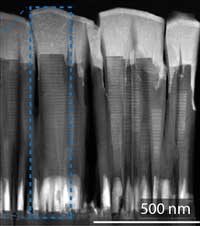 Researchers succeeded in creating light-emitting diodes, or LEDs, from a graphene nanomaterial that emits ultraviolet light.
Researchers succeeded in creating light-emitting diodes, or LEDs, from a graphene nanomaterial that emits ultraviolet light.
Wednesday, April 24, 2019
Graphene nanomaterial to replace mercury in LEDs
 Researchers succeeded in creating light-emitting diodes, or LEDs, from a graphene nanomaterial that emits ultraviolet light.
Researchers succeeded in creating light-emitting diodes, or LEDs, from a graphene nanomaterial that emits ultraviolet light.
Graphene quantum dots could yield treatment for traumatic injuries
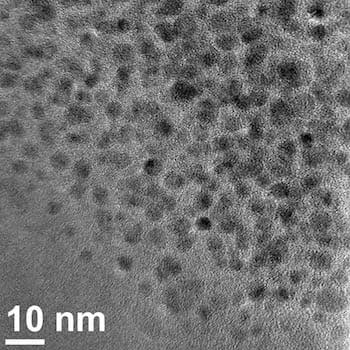 Graphene quantum dots drawn from common coal may be the basis for an effective antioxidant for people who suffer traumatic brain injuries, strokes or heart attacks.
Graphene quantum dots drawn from common coal may be the basis for an effective antioxidant for people who suffer traumatic brain injuries, strokes or heart attacks.
Nano-imaging system helps surgeons remove tiny ovarian tumors
 Real-time carbon nanotube based fluorescent imaging could boost survival rates for ovarian cancer.
Real-time carbon nanotube based fluorescent imaging could boost survival rates for ovarian cancer.
Study shows the potential of carbon nanotubes to cool electronic circuits
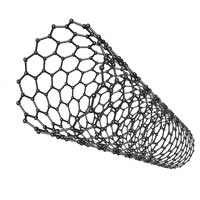 Mechanically stretched carbon nanotubes extract heat efficiently and could be used to cool flexible electronic devices.
Mechanically stretched carbon nanotubes extract heat efficiently and could be used to cool flexible electronic devices.
Polymers to give early warning signs
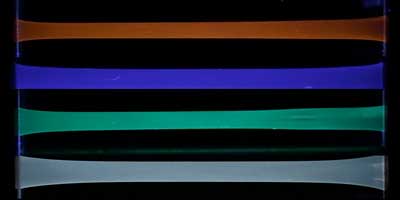 Scientists have developed a method to tailor the properties of stress-indicating molecules that can be integrated into polymers and signal damages or excessive mechanical loads with an optical signal.
Scientists have developed a method to tailor the properties of stress-indicating molecules that can be integrated into polymers and signal damages or excessive mechanical loads with an optical signal.
Nanosized container with photoswitches: release of cargo upon irradiation in water
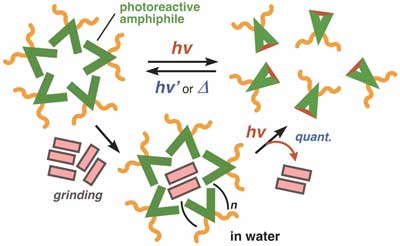 A versatile system with potential application for non-invasive drug delivery.
A versatile system with potential application for non-invasive drug delivery.
'Nanofiber yarn' makes for stretchy, protective artificial tissue
 Twisted fibers coated with living cells could assist healing of injured muscles and tendons.
Twisted fibers coated with living cells could assist healing of injured muscles and tendons.
Printed organic electronics you can eat
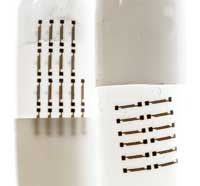 Researchers report that organic transistors composed mainly of ingestible materials can be easily transferred on edible substrates by means of untreated commercial tattoo-paper.
Researchers report that organic transistors composed mainly of ingestible materials can be easily transferred on edible substrates by means of untreated commercial tattoo-paper.
Quantum distillery for light
 The distillation of spirits increases the content of alcohol relative to the water content. A similar method works on light quanta - photons. It extracts individual photons from a light source, reduces the unwanted vacuum component, and heralds this event.
The distillation of spirits increases the content of alcohol relative to the water content. A similar method works on light quanta - photons. It extracts individual photons from a light source, reduces the unwanted vacuum component, and heralds this event.
New nanomedicine slips through the cracks
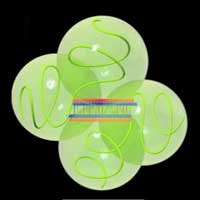 Nanomachines aim to deliver cancer drugs to hard-to-reach areas like the brain.
Nanomachines aim to deliver cancer drugs to hard-to-reach areas like the brain.
Highly fire retardant coating developed from nanocellulose
 A spray- or brush-applied fire retardant coating made from nanocellulose is well suited for improving the fire properties of wood-based materials. It reduces the access of oxygen to the surface, thus significantly inhibiting combustion.
A spray- or brush-applied fire retardant coating made from nanocellulose is well suited for improving the fire properties of wood-based materials. It reduces the access of oxygen to the surface, thus significantly inhibiting combustion.
Subscribe to:
Comments (Atom)
